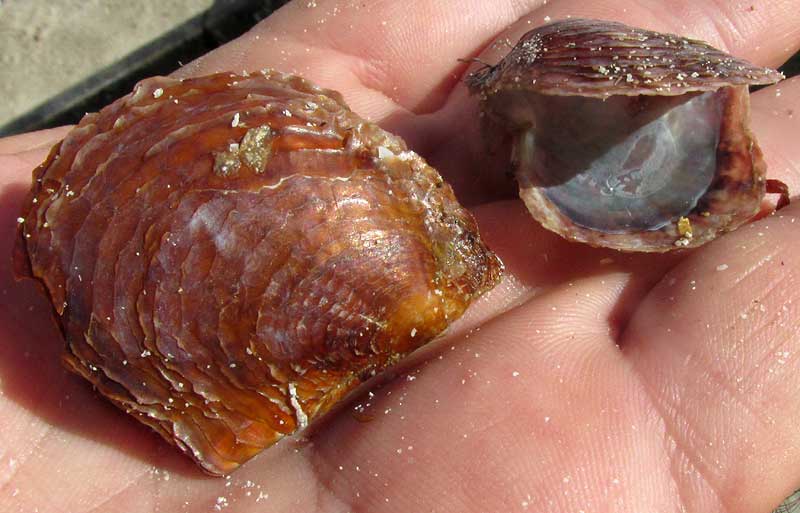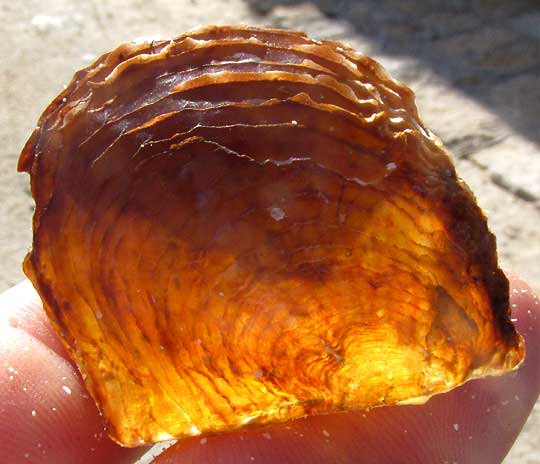Excerpts from Jim Conrad's
Naturalist Newsletter

from the February 1, 2015 Newsletter issued from Río Lagartos, on the Yucatan Peninsula's northern coast (~N21.60°, ~W88.16°), Yucatán state, MÉXICO
ATLANTIC PEARL OYSTER
On the Gulf of Mexico beach of the long finger of land across the estuary from Río Lagartos, a norte with its stiff northerly breezes had heaped up great mounds of seaweed and seashells. Among the shells were the small, clam-like bivalves shown above.
These caught my eyes with their rich, amber-brown color and the unusual, irregularly formed, concentric growth-bands ornamenting the shells' surfaces. Inside the shells, which seemed thin and brittle compared to others on the beach, the surfaces were smooth and pearly white. Holding up a shell to better see the growth bands, sunlight transluced through the shell in a special way, shown below:

It's surprisingly hard to identify shells found on the Yucatan's beaches. Some small collections from the Florida and Caribbean area are online but none included this shell. Finally I remembered that one kind of shell that is somewhat irregularly shaped and pearly inside is the oyster shell, so I looked for images of shells of various oyster types, and that was the breakthrough.
Here we have the Atlantic Pearl Oyster, PINCTADA IMBRICATA, an ecologically and economically important species in many parts of the world, not only the Atlantic. In many places where Atlantic Pearl Oysters aren't native, they've been introduced for the cultivation and production of natural pearls. Pearl oyster species are not closely related to either edible oysters of the Family Ostreidae, or freshwater pearl mussels of the families Unionidae and Margaritiferidae but rather constitute their own family, the Pearl Oyster Family, the Pteriidae. The pteri in Pteriidae" is the Latin nominative masculine plural form of pterus, which means "winged," referring to the flattish wing extensions at the shell's rear ends, where they're hinged.
Though so far we've looked at only a handful of seashell-producing mollusks found on the beach here, this is the second species famed for its pearl producing ability. The other was the Atlantic Winged Oyster, also a member of the Pearl Oyster Family, profiled at www.backyardnature.net/yucatan/pteria.htm.
Finding these two pearl-producing species washed up on our beach gives the impression that our waters may be good for pearl-oyster cultivation, and maybe capable of supporting a new source of income for the region. The idea must be approached cautiously, though, for sometimes commercial aquaculture is ruinous to the local ecosystem, especially when it converts mangroves to commercial fishponds.
During his third voyage to the Americas, in 1498, Christopher Columbus found Atlantic Pearl Oysters off the coast of Venezuela, and took pearls from them back to Spain. Consequently, the first Spanish town in the New World was established in 1528 on the Venezuelan island of Cubagua to serve as a center for harvesting pearl oysters and collecting pearls. The oysters were so overharvested that eventually they nearly went extinct in those waters.
A fascinating, illustrated paper entitled "History of the Atlantic Pearl-Oyster, Pinctata imbricata, Industry in Venezuela and Colombia, with Biological and Ecological Observations" can be downloaded for free in PDF format at http://aquaticcommons.org/9736/1/mfr6511.pdf.
This whole matter of pearls is fascinating, and a good place to learn the basics of how pearls form naturally in oysters, how they are cultivated commercially, and all the things people do with pearls, is the Wikipedia Pearl Page at https://en.wikipedia.org/wiki/Pearl.